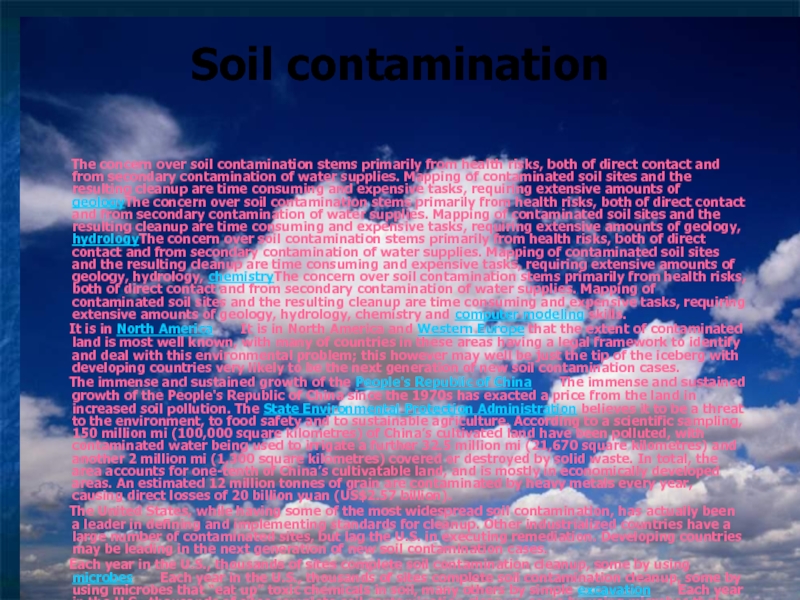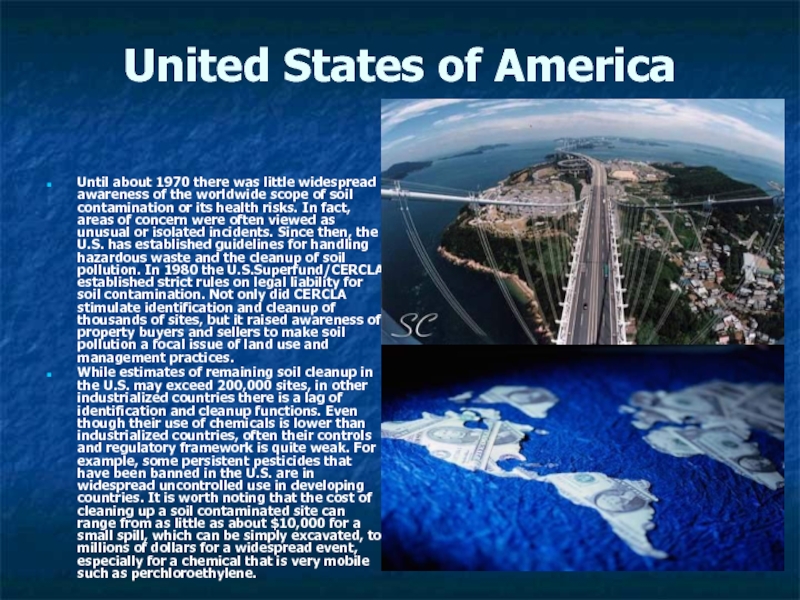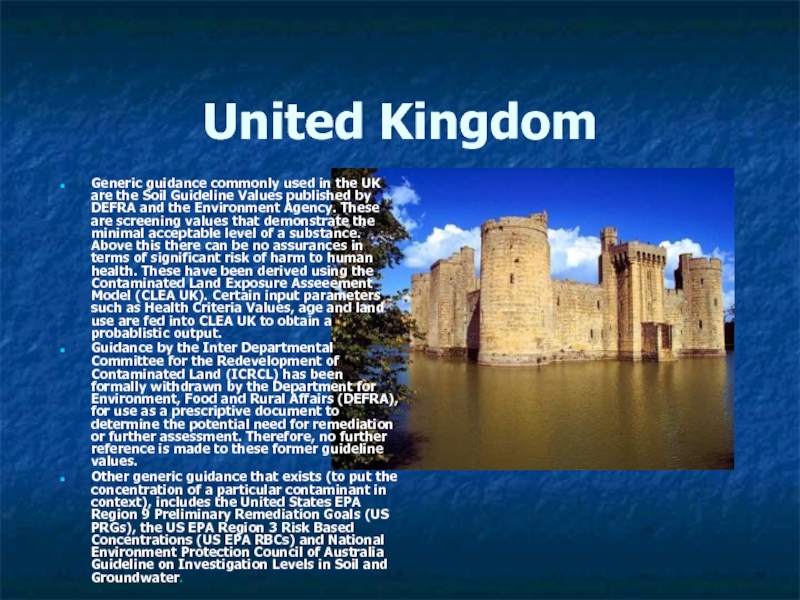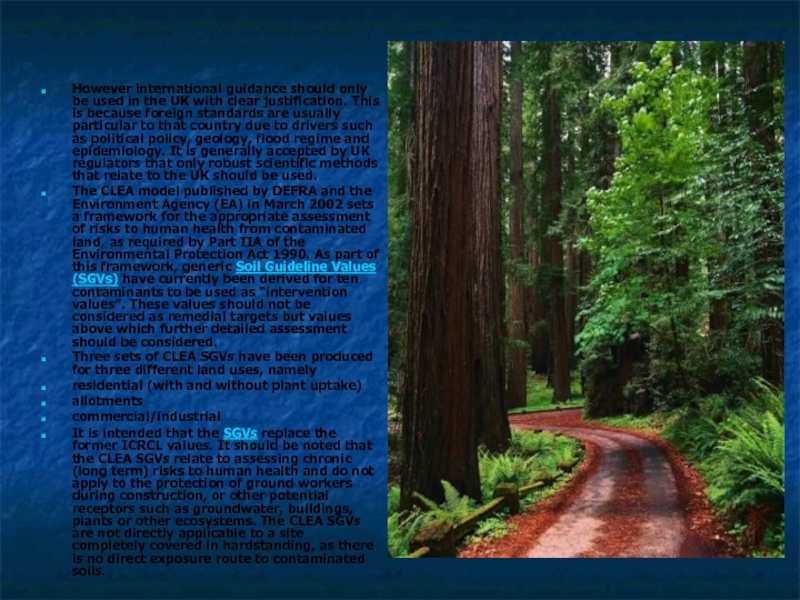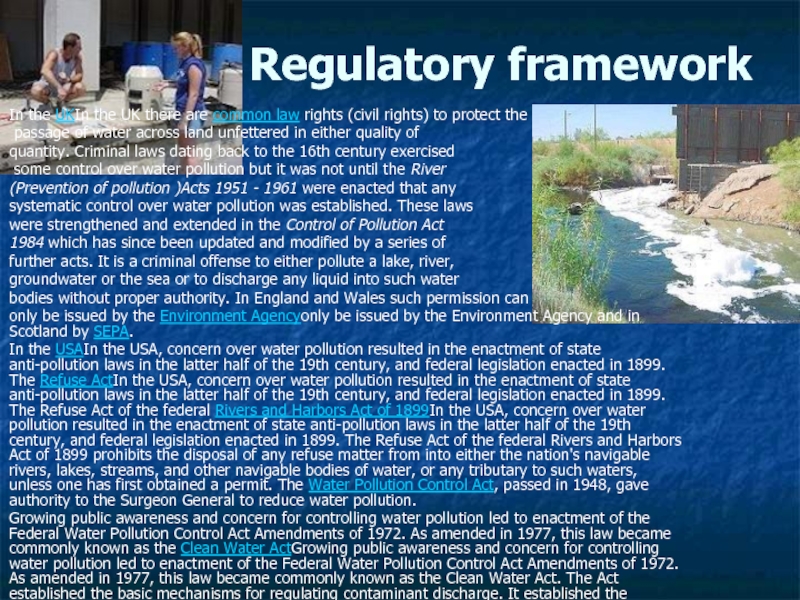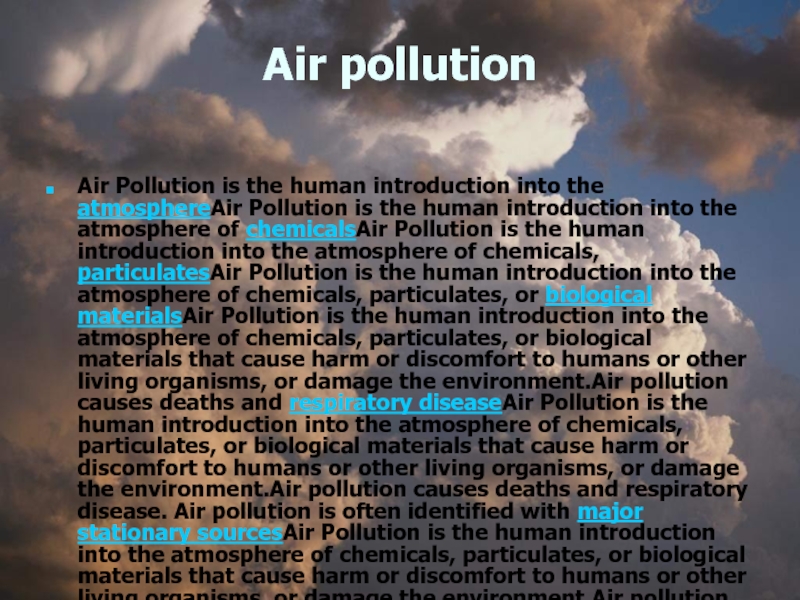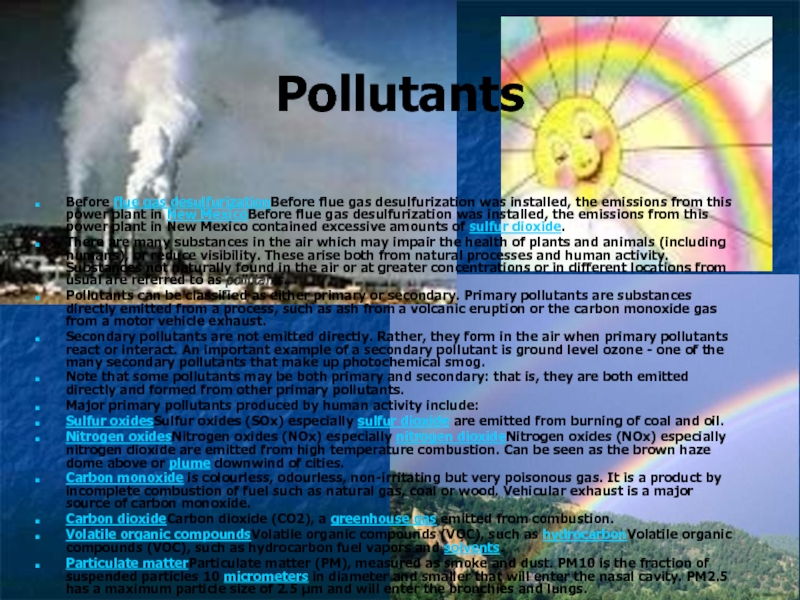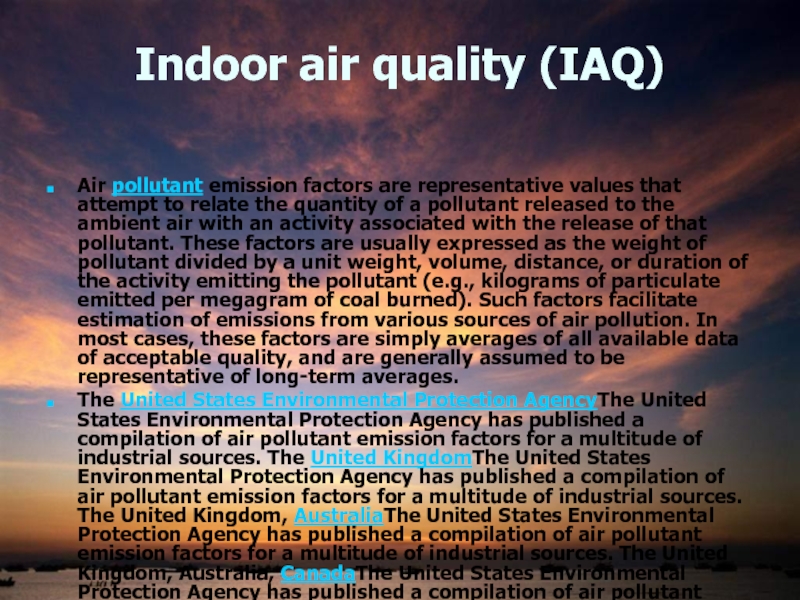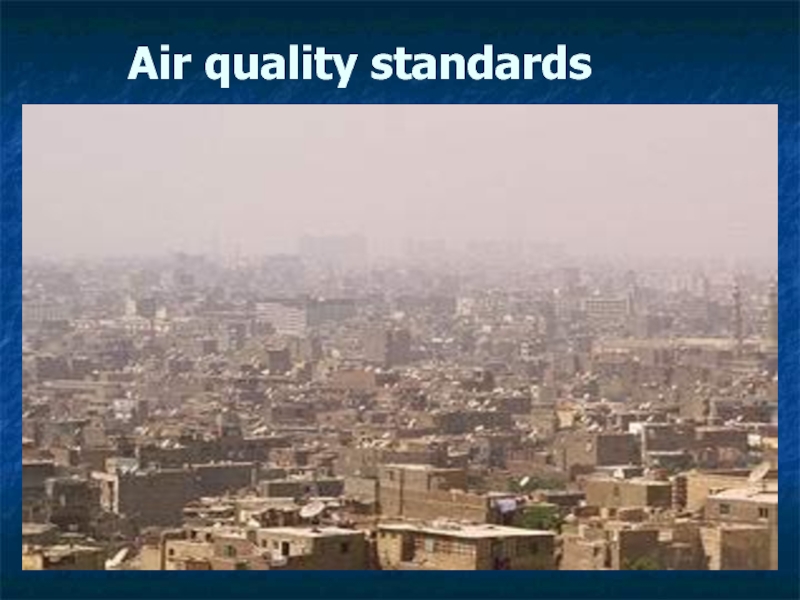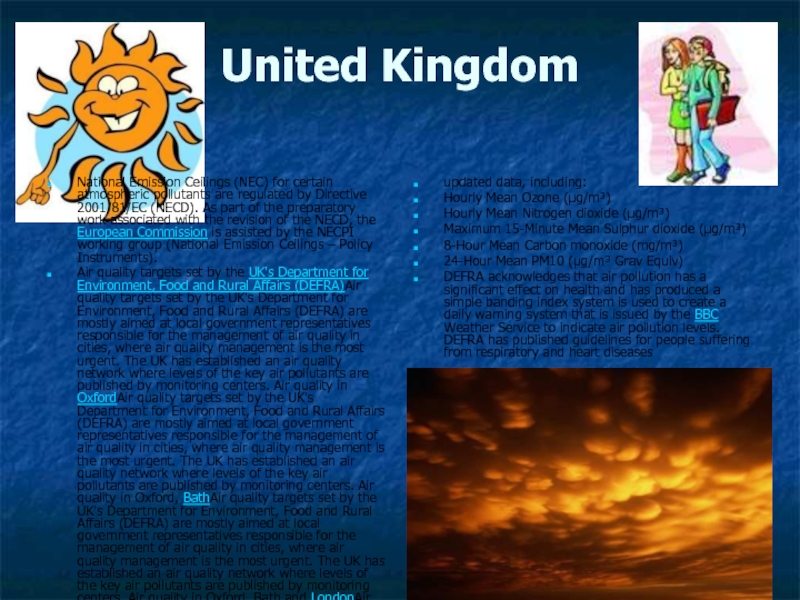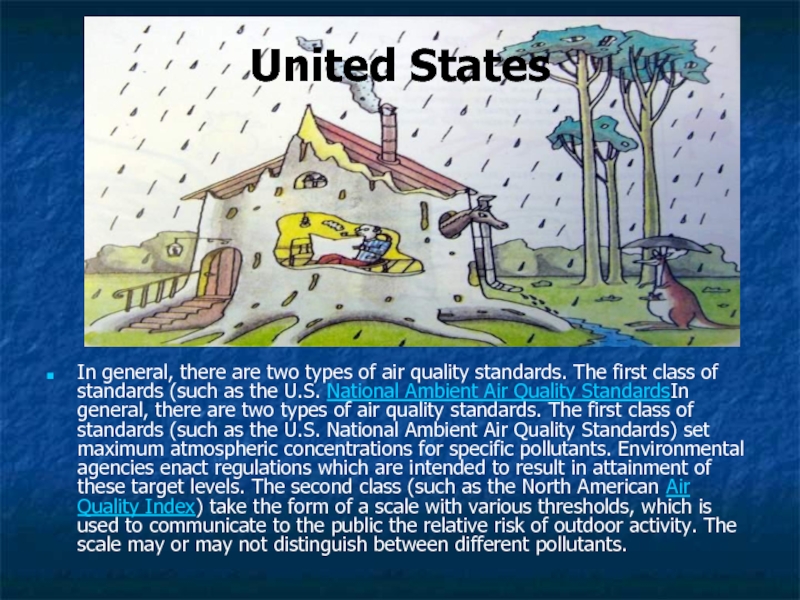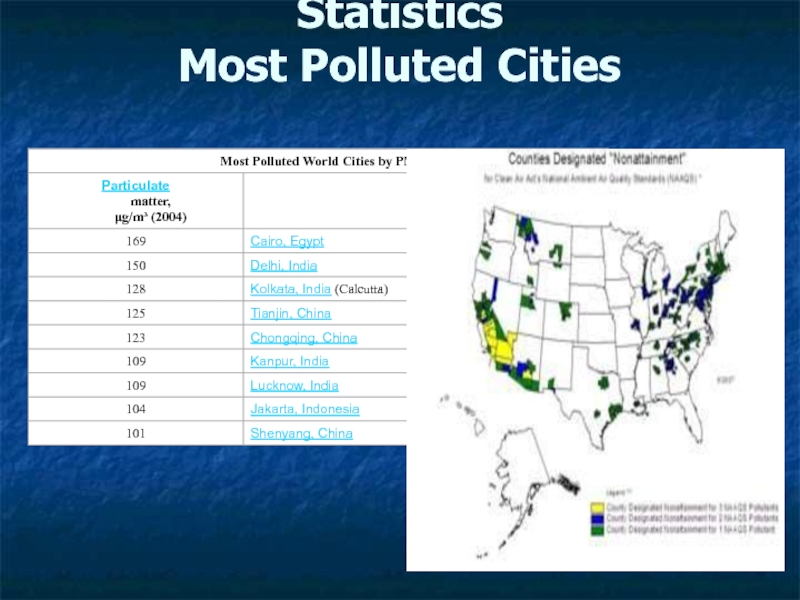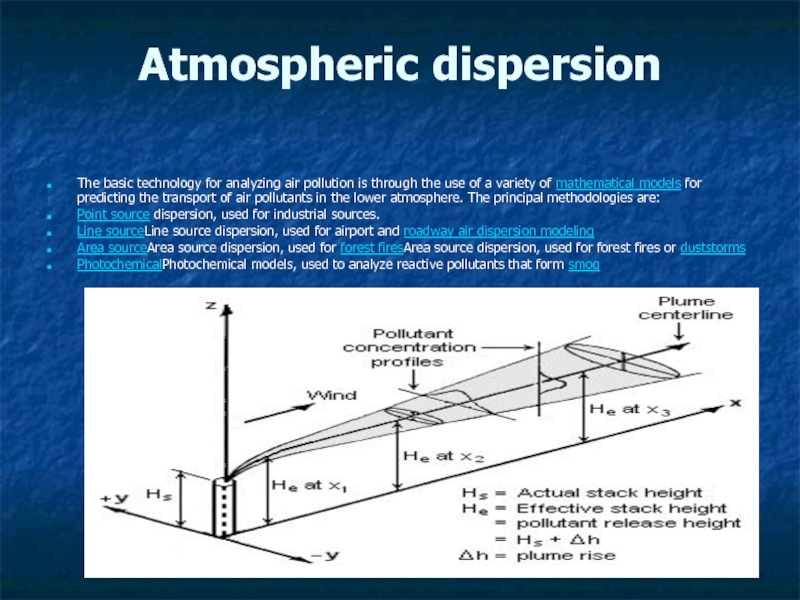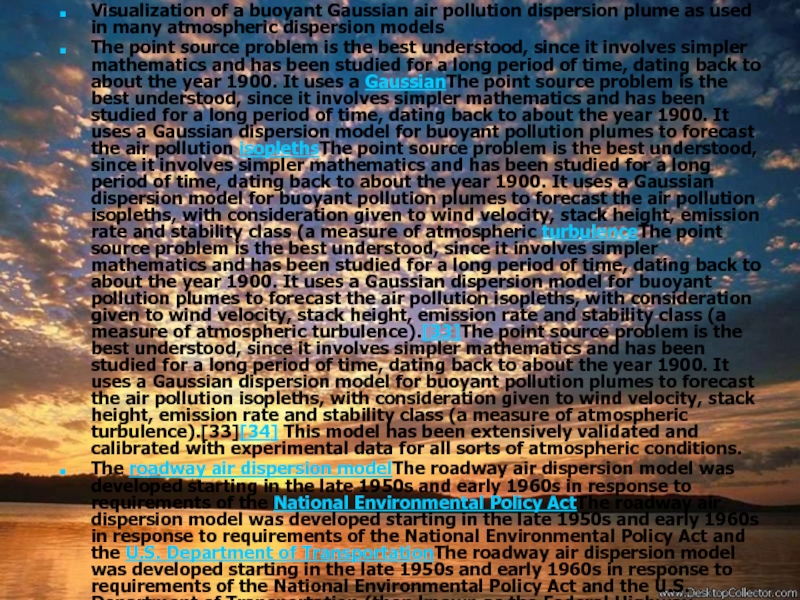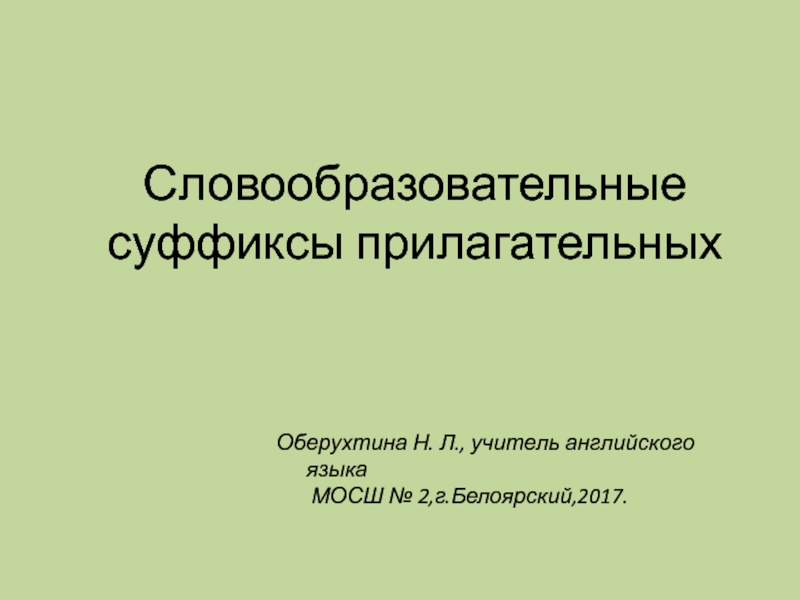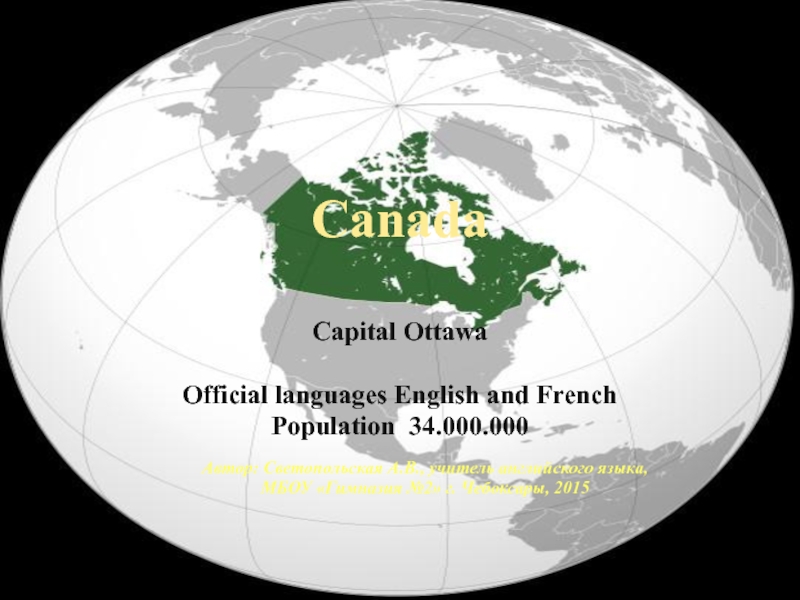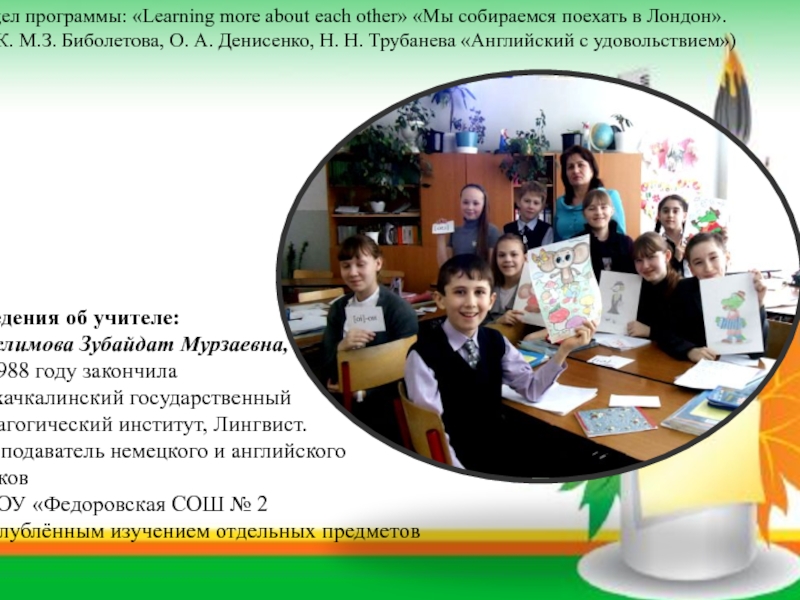Разделы презентаций
- Разное
- Английский язык
- Астрономия
- Алгебра
- Биология
- География
- Геометрия
- Детские презентации
- Информатика
- История
- Литература
- Математика
- Медицина
- Менеджмент
- Музыка
- МХК
- Немецкий язык
- ОБЖ
- Обществознание
- Окружающий мир
- Педагогика
- Русский язык
- Технология
- Физика
- Философия
- Химия
- Шаблоны, картинки для презентаций
- Экология
- Экономика
- Юриспруденция
Ecology save our nature
Содержание
- 1. Ecology save our nature
- 2. Soil contamination Soil contamination
- 3. Soil contamination The
- 4. United States of America Until about 1970
- 5. United Kingdom Generic guidance commonly used in
- 6. However international guidance should only be used
- 7. To date, the first ten of fifty-five
- 8. Water pollution Water pollution is the contamination
- 9. Regulatory framework In the UKIn the UK
- 10. Air Pollution is the human introduction into
- 11. Pollutants Before flue gas desulfurizationBefore flue gas
- 12. Sources Anthropogenic sources (human activity) mostly related
- 13. Indoor air quality (IAQ) Air pollutant emission
- 14. Air quality standards
- 15. United Kingdom National Emission Ceilings (NEC) for
- 16. United States In general, there are two
- 17. Statistics Most Polluted Cities
- 18. Atmospheric dispersion The basic technology for analyzing
- 19. Visualization of a buoyant Gaussian air pollution
- 20. How should WE change OUR lifeSort all
- 21. Thank you for attention!
- 22. Скачать презентанцию
Слайды и текст этой презентации
Слайд 3Soil contamination
The concern over soil contamination
stems primarily from health risks, both of direct contact and
from secondary contamination of water supplies. Mapping of contaminated soil sites and the resulting cleanup are time consuming and expensive tasks, requiring extensive amounts of geologyThe concern over soil contamination stems primarily from health risks, both of direct contact and from secondary contamination of water supplies. Mapping of contaminated soil sites and the resulting cleanup are time consuming and expensive tasks, requiring extensive amounts of geology, hydrologyThe concern over soil contamination stems primarily from health risks, both of direct contact and from secondary contamination of water supplies. Mapping of contaminated soil sites and the resulting cleanup are time consuming and expensive tasks, requiring extensive amounts of geology, hydrology, chemistryThe concern over soil contamination stems primarily from health risks, both of direct contact and from secondary contamination of water supplies. Mapping of contaminated soil sites and the resulting cleanup are time consuming and expensive tasks, requiring extensive amounts of geology, hydrology, chemistry and computer modeling skills.It is in North America It is in North America and Western Europe that the extent of contaminated land is most well known, with many of countries in these areas having a legal framework to identify and deal with this environmental problem; this however may well be just the tip of the iceberg with developing countries very likely to be the next generation of new soil contamination cases.
The immense and sustained growth of the People's Republic of China The immense and sustained growth of the People's Republic of China since the 1970s has exacted a price from the land in increased soil pollution. The State Environmental Protection Administration believes it to be a threat to the environment, to food safety and to sustainable agriculture. According to a scientific sampling, 150 million mi (100,000 square kilometres) of China’s cultivated land have been polluted, with contaminated water being used to irrigate a further 32.5 million mi (21,670 square kilometres) and another 2 million mi (1,300 square kilometres) covered or destroyed by solid waste. In total, the area accounts for one-tenth of China’s cultivatable land, and is mostly in economically developed areas. An estimated 12 million tonnes of grain are contaminated by heavy metals every year, causing direct losses of 20 billion yuan (US$2.57 billion).
The United States, while having some of the most widespread soil contamination, has actually been a leader in defining and implementing standards for cleanup. Other industrialized countries have a large number of contaminated sites, but lag the U.S. in executing remediation. Developing countries may be leading in the next generation of new soil contamination cases.
Each year in the U.S., thousands of sites complete soil contamination cleanup, some by using microbes Each year in the U.S., thousands of sites complete soil contamination cleanup, some by using microbes that “eat up” toxic chemicals in soil, many others by simple excavation Each year in the U.S., thousands of sites complete soil contamination cleanup, some by using microbes that “eat up” toxic chemicals in soil, many others by simple excavation and others by more expensive high-tech soil vapor extraction or air stripping. At the same time, efforts proceed worldwide in creating and identifying new sites of soil contamination, particularly in industrial countries other than the U.S., and in developing countries which lack the money and the technology to adequately protect soil resources.
Слайд 4United States of America
Until about 1970 there was little widespread
awareness of the worldwide scope of soil contamination or its
health risks. In fact, areas of concern were often viewed as unusual or isolated incidents. Since then, the U.S. has established guidelines for handling hazardous waste and the cleanup of soil pollution. In 1980 the U.S.Superfund/CERCLA established strict rules on legal liability for soil contamination. Not only did CERCLA stimulate identification and cleanup of thousands of sites, but it raised awareness of property buyers and sellers to make soil pollution a focal issue of land use and management practices.While estimates of remaining soil cleanup in the U.S. may exceed 200,000 sites, in other industrialized countries there is a lag of identification and cleanup functions. Even though their use of chemicals is lower than industrialized countries, often their controls and regulatory framework is quite weak. For example, some persistent pesticides that have been banned in the U.S. are in widespread uncontrolled use in developing countries. It is worth noting that the cost of cleaning up a soil contaminated site can range from as little as about $10,000 for a small spill, which can be simply excavated, to millions of dollars for a widespread event, especially for a chemical that is very mobile such as perchloroethylene.
Слайд 5United Kingdom
Generic guidance commonly used in the UK are
the Soil Guideline Values published by DEFRA and the Environment
Agency. These are screening values that demonstrate the minimal acceptable level of a substance. Above this there can be no assurances in terms of significant risk of harm to human health. These have been derived using the Contaminated Land Exposure Asseeement Model (CLEA UK). Certain input parameters such as Health Criteria Values, age and land use are fed into CLEA UK to obtain a probablistic output.Guidance by the Inter Departmental Committee for the Redevelopment of Contaminated Land (ICRCL) has been formally withdrawn by the Department for Environment, Food and Rural Affairs (DEFRA), for use as a prescriptive document to determine the potential need for remediation or further assessment. Therefore, no further reference is made to these former guideline values.
Other generic guidance that exists (to put the concentration of a particular contaminant in context), includes the United States EPA Region 9 Preliminary Remediation Goals (US PRGs), the US EPA Region 3 Risk Based Concentrations (US EPA RBCs) and National Environment Protection Council of Australia Guideline on Investigation Levels in Soil and Groundwater.
Слайд 6
However international guidance should only be used in the UK
with clear justification. This is because foreign standards are usually
particular to that country due to drivers such as political policy, geology, flood regime and epidemiology. It is generally accepted by UK regulators that only robust scientific methods that relate to the UK should be used.The CLEA model published by DEFRA and the Environment Agency (EA) in March 2002 sets a framework for the appropriate assessment of risks to human health from contaminated land, as required by Part IIA of the Environmental Protection Act 1990. As part of this framework, generic Soil Guideline Values (SGVs) have currently been derived for ten contaminants to be used as “intervention values”. These values should not be considered as remedial targets but values above which further detailed assessment should be considered.
Three sets of CLEA SGVs have been produced for three different land uses, namely
residential (with and without plant uptake)
allotments
commercial/industrial
It is intended that the SGVs replace the former ICRCL values. It should be noted that the CLEA SGVs relate to assessing chronic (long term) risks to human health and do not apply to the protection of ground workers during construction, or other potential receptors such as groundwater, buildings, plants or other ecosystems. The CLEA SGVs are not directly applicable to a site completely covered in hardstanding, as there is no direct exposure route to contaminated soils.
Слайд 7
To date, the first ten of fifty-five contaminant SGVs have
been published, for the following: arsenic, cadmium, chromium, lead, inorganic
mercury, nickel, selenium ethyl benzene, phenol and toluene. Draft SGVs for benzene, naphthalene and xylene have been produced but their publication is on hold. Toxicological data (Tox) has been published for each of these contaminants as well as for benzo[a]pyrene, benzene, dioxins, furans and dioxin-like PCBs, naphthalene, vinyl chloride, 1,1,2,2 tetrachloroethane and 1,1,1,2 tetrachloroethane, 1,1,1 trichloroethane, tetrachloroethene, carbon tetrachloride, 1,2-dichloroethane, trichloroethene and xylene. The SGVs for ethyl benzene, phenol and toluene are dependent on the soil organic matter (SOM) content (which can be calculated from the total organic carbon (TOC) content). As an initial screen the SGVs for 1% SOM are considered to be appropriate.Слайд 8Water pollution
Water pollution is the contamination of waterWater pollution is
the contamination of water bodies such as lakesWater pollution is
the contamination of water bodies such as lakes, riversWater pollution is the contamination of water bodies such as lakes, rivers, oceansWater pollution is the contamination of water bodies such as lakes, rivers, oceans, and groundwater caused by human activities, which can be harmful to organisms and plants which live in these water bodies.Although natural phenomena such as volcanoesAlthough natural phenomena such as volcanoes, algae bloomsAlthough natural phenomena such as volcanoes, algae blooms, stormsAlthough natural phenomena such as volcanoes, algae blooms, storms, and earthquakesAlthough natural phenomena such as volcanoes, algae blooms, storms, and earthquakes also cause major changes in water qualityAlthough natural phenomena such as volcanoes, algae blooms, storms, and earthquakes also cause major changes in water quality and the ecological status of water, water is only called polluted when it is not able to be used for what one wants it to be used for. Water pollution has many causes and characteristics. Increases in nutrientAlthough natural phenomena such as volcanoes, algae blooms, storms, and earthquakes also cause major changes in water quality and the ecological status of water, water is only called polluted when it is not able to be used for what one wants it to be used for. Water pollution has many causes and characteristics. Increases in nutrient loading may lead to eutrophicationAlthough natural phenomena such as volcanoes, algae blooms, storms, and earthquakes also cause major changes in water quality and the ecological status of water, water is only called polluted when it is not able to be used for what one wants it to be used for. Water pollution has many causes and characteristics. Increases in nutrient loading may lead to eutrophication. Organic wastes such as sewageAlthough natural phenomena such as volcanoes, algae blooms, storms, and earthquakes also cause major changes in water quality and the ecological status of water, water is only called polluted when it is not able to be used for what one wants it to be used for. Water pollution has many causes and characteristics. Increases in nutrient loading may lead to eutrophication. Organic wastes such as sewage impose high oxygenAlthough natural phenomena such as volcanoes, algae blooms, storms, and earthquakes also cause major changes in water quality and the ecological status of water, water is only called polluted when it is not able to be used for what one wants it to be used for. Water pollution has many causes and characteristics. Increases in nutrient loading may lead to eutrophication. Organic wastes such as sewage impose high oxygen demands on the receiving water leading to oxygen depletion with potentially severe impacts on the whole eco-system. Industries discharge a variety of pollutants in their wastewaterAlthough natural phenomena such as volcanoes, algae blooms, storms, and earthquakes also cause major changes in water quality and the ecological status of water, water is only called polluted when it is not able to be used for what one wants it to be used for. Water pollution has many causes and characteristics. Increases in nutrient loading may lead to eutrophication. Organic wastes such as sewage impose high oxygen demands on the receiving water leading to oxygen depletion with potentially severe impacts on the whole eco-system. Industries discharge a variety of pollutants in their wastewater including heavy metalsAlthough natural phenomena such as volcanoes, algae blooms, storms, and earthquakes also cause major changes in water quality and the ecological status of water, water is only called polluted when it is not able to be used for what one wants it to be used for. Water pollution has many causes and characteristics. Increases in nutrient loading may lead to eutrophication. Organic wastes such as sewage impose high oxygen demands on the receiving water leading to oxygen depletion with potentially severe impacts on the whole eco-system. Industries discharge a variety of pollutants in their wastewater including heavy metals, resin pellets, organic toxins, oils, nutrients, and solids. Discharges can also have thermal effects, especially those from power stations, and these too reduce the available oxygen. SiltAlthough natural phenomena such as volcanoes, algae blooms, storms, and earthquakes also cause major changes in water quality and the ecological status of water, water is only called polluted when it is not able to be used for what one wants it to be used for. Water pollution has many causes and characteristics. Increases in nutrient loading may lead to eutrophication. Organic wastes such as sewage impose high oxygen demands on the receiving water leading to oxygen depletion with potentially severe impacts on the whole eco-system. Industries discharge a variety of pollutants in their wastewater including heavy metals, resin pellets, organic toxins, oils, nutrients, and solids. Discharges can also have thermal effects, especially those from power stations, and these too reduce the available oxygen. Silt-bearing runoff from many activities including constructionAlthough natural phenomena such as volcanoes, algae blooms, storms, and earthquakes also cause major changes in water quality and the ecological status of water, water is only called polluted when it is not able to be used for what one wants it to be used for. Water pollution has many causes and characteristics. Increases in nutrient loading may lead to eutrophication. Organic wastes such as sewage impose high oxygen demands on the receiving water leading to oxygen depletion with potentially severe impacts on the whole eco-system. Industries discharge a variety of pollutants in their wastewater including heavy metals, resin pellets, organic toxins, oils, nutrients, and solids. Discharges can also have thermal effects, especially those from power stations, and these too reduce the available oxygen. Silt-bearing runoff from many activities including construction sites, deforestationAlthough natural phenomena such as volcanoes, algae blooms, storms, and earthquakes also cause major changes in water quality and the ecological status of water, water is only called polluted when it is not able to be used for what one wants it to be used for. Water pollution has many causes and characteristics. Increases in nutrient loading may lead to eutrophication. Organic wastes such as sewage impose high oxygen demands on the receiving water leading to oxygen depletion with potentially severe impacts on the whole eco-system. Industries discharge a variety of pollutants in their wastewater including heavy metals, resin pellets, organic toxins, oils, nutrients, and solids. Discharges can also have thermal effects, especially those from power stations, and these too reduce the available oxygen. Silt-bearing runoff from many activities including construction sites, deforestation and agricultureAlthough natural phenomena such as volcanoes, algae blooms, storms, and earthquakes also cause major changes in water quality and the ecological status of water, water is only called polluted when it is not able to be used for what one wants it to be used for. Water pollution has many causes and characteristics. Increases in nutrient loading may lead to eutrophication. Organic wastes such as sewage impose high oxygen demands on the receiving water leading to oxygen depletion with potentially severe impacts on the whole eco-system. Industries discharge a variety of pollutants in their wastewater including heavy metals, resin pellets, organic toxins, oils, nutrients, and solids. Discharges can also have thermal effects, especially those from power stations, and these too reduce the available oxygen. Silt-bearing runoff from many activities including construction sites, deforestation and agriculture can inhibit the penetration of sunlight through the water column, restricting photosynthesisAlthough natural phenomena such as volcanoes, algae blooms, storms, and earthquakes also cause major changes in water quality and the ecological status of water, water is only called polluted when it is not able to be used for what one wants it to be used for. Water pollution has many causes and characteristics. Increases in nutrient loading may lead to eutrophication. Organic wastes such as sewage impose high oxygen demands on the receiving water leading to oxygen depletion with potentially severe impacts on the whole eco-system. Industries discharge a variety of pollutants in their wastewater including heavy metals, resin pellets, organic toxins, oils, nutrients, and solids. Discharges can also have thermal effects, especially those from power stations, and these too reduce the available oxygen. Silt-bearing runoff from many activities including construction sites, deforestation and agriculture can inhibit the penetration of sunlight through the water column, restricting photosynthesis and causing blanketing of the lake or river bed, in turn damaging ecological systems.
Pollution in water include a wide spectrum of chemicalsPollution in water include a wide spectrum of chemicals, pathogensPollution in water include a wide spectrum of chemicals, pathogens, and physical chemistry or sensory changes. Many of the chemical substances are toxicPollution in water include a wide spectrum of chemicals, pathogens, and physical chemistry or sensory changes. Many of the chemical substances are toxic. Pathogens can produce waterborne diseasesPollution in water include a wide spectrum of chemicals, pathogens, and physical chemistry or sensory changes. Many of the chemical substances are toxic. Pathogens can produce waterborne diseases in either human or animal hosts. Alteration of water's physical chemistry include acidity, electrical conductivityPollution in water include a wide spectrum of chemicals, pathogens, and physical chemistry or sensory changes. Many of the chemical substances are toxic. Pathogens can produce waterborne diseases in either human or animal hosts. Alteration of water's physical chemistry include acidity, electrical conductivity, temperature, and eutrophication. EutrophicationPollution in water include a wide spectrum of chemicals, pathogens, and physical chemistry or sensory changes. Many of the chemical substances are toxic. Pathogens can produce waterborne diseases in either human or animal hosts. Alteration of water's physical chemistry include acidity, electrical conductivity, temperature, and eutrophication. Eutrophication is the fertilisationPollution in water include a wide spectrum of chemicals, pathogens, and physical chemistry or sensory changes. Many of the chemical substances are toxic. Pathogens can produce waterborne diseases in either human or animal hosts. Alteration of water's physical chemistry include acidity, electrical conductivity, temperature, and eutrophication. Eutrophication is the fertilisation of surface waterPollution in water include a wide spectrum of chemicals, pathogens, and physical chemistry or sensory changes. Many of the chemical substances are toxic. Pathogens can produce waterborne diseases in either human or animal hosts. Alteration of water's physical chemistry include acidity, electrical conductivity, temperature, and eutrophication. Eutrophication is the fertilisation of surface water by nutrientsPollution in water include a wide spectrum of chemicals, pathogens, and physical chemistry or sensory changes. Many of the chemical substances are toxic. Pathogens can produce waterborne diseases in either human or animal hosts. Alteration of water's physical chemistry include acidity, electrical conductivity, temperature, and eutrophication. Eutrophication is the fertilisation of surface water by nutrients that were previously scarce. Even many of the municipal water supplies in developed countries can present health risks. Water pollution is a major problem in the global context. It has been suggested that it is the leading worldwide cause of deaths and diseases, and that it accounts for the deaths of more than 14,000 people daily.
Слайд 9Regulatory framework
In the UKIn the UK there are common law
rights (civil rights) to protect the
passage of water across
land unfettered in either quality of quantity. Criminal laws dating back to the 16th century exercised
some control over water pollution but it was not until the River
(Prevention of pollution )Acts 1951 - 1961 were enacted that any
systematic control over water pollution was established. These laws
were strengthened and extended in the Control of Pollution Act
1984 which has since been updated and modified by a series of
further acts. It is a criminal offense to either pollute a lake, river,
groundwater or the sea or to discharge any liquid into such water
bodies without proper authority. In England and Wales such permission can
only be issued by the Environment Agencyonly be issued by the Environment Agency and in Scotland by SEPA.
In the USAIn the USA, concern over water pollution resulted in the enactment of state anti-pollution laws in the latter half of the 19th century, and federal legislation enacted in 1899. The Refuse ActIn the USA, concern over water pollution resulted in the enactment of state anti-pollution laws in the latter half of the 19th century, and federal legislation enacted in 1899. The Refuse Act of the federal Rivers and Harbors Act of 1899In the USA, concern over water pollution resulted in the enactment of state anti-pollution laws in the latter half of the 19th century, and federal legislation enacted in 1899. The Refuse Act of the federal Rivers and Harbors Act of 1899 prohibits the disposal of any refuse matter from into either the nation's navigable rivers, lakes, streams, and other navigable bodies of water, or any tributary to such waters, unless one has first obtained a permit. The Water Pollution Control Act, passed in 1948, gave authority to the Surgeon General to reduce water pollution.
Growing public awareness and concern for controlling water pollution led to enactment of the Federal Water Pollution Control Act Amendments of 1972. As amended in 1977, this law became commonly known as the Clean Water ActGrowing public awareness and concern for controlling water pollution led to enactment of the Federal Water Pollution Control Act Amendments of 1972. As amended in 1977, this law became commonly known as the Clean Water Act. The Act established the basic mechanisms for regulating contaminant discharge. It established the authority for the United States Environmental Protection Agency to implement wastewater standards for industry. The Clean Water Act also continued requirements to set water quality standards for all contaminants in surface waters. Further amplification of the Act continued including the enactment of the Great Lakes Legacy Act of 2002.
In 2004, the United States Environmental Protection Agency tested drinking water quality on commercial airline's aircraft and found that 15 percent of tested aircraft tested positive for total coliform bacteria, according to a press release issued on Friday March 28, 2008.
Слайд 10Air Pollution is the human introduction into the atmosphereAir Pollution
is the human introduction into the atmosphere of chemicalsAir Pollution
is the human introduction into the atmosphere of chemicals, particulatesAir Pollution is the human introduction into the atmosphere of chemicals, particulates, or biological materialsAir Pollution is the human introduction into the atmosphere of chemicals, particulates, or biological materials that cause harm or discomfort to humans or other living organisms, or damage the environment.Air pollution causes deaths and respiratory diseaseAir Pollution is the human introduction into the atmosphere of chemicals, particulates, or biological materials that cause harm or discomfort to humans or other living organisms, or damage the environment.Air pollution causes deaths and respiratory disease. Air pollution is often identified with major stationary sourcesAir Pollution is the human introduction into the atmosphere of chemicals, particulates, or biological materials that cause harm or discomfort to humans or other living organisms, or damage the environment.Air pollution causes deaths and respiratory disease. Air pollution is often identified with major stationary sources, but the greatest source of emissionsAir Pollution is the human introduction into the atmosphere of chemicals, particulates, or biological materials that cause harm or discomfort to humans or other living organisms, or damage the environment.Air pollution causes deaths and respiratory disease. Air pollution is often identified with major stationary sources, but the greatest source of emissions is actually mobile sources, mainly automobilesAir Pollution is the human introduction into the atmosphere of chemicals, particulates, or biological materials that cause harm or discomfort to humans or other living organisms, or damage the environment.Air pollution causes deaths and respiratory disease. Air pollution is often identified with major stationary sources, but the greatest source of emissions is actually mobile sources, mainly automobiles. Gases such as carbon dioxideAir Pollution is the human introduction into the atmosphere of chemicals, particulates, or biological materials that cause harm or discomfort to humans or other living organisms, or damage the environment.Air pollution causes deaths and respiratory disease. Air pollution is often identified with major stationary sources, but the greatest source of emissions is actually mobile sources, mainly automobiles. Gases such as carbon dioxide, which contribute to global warmingAir Pollution is the human introduction into the atmosphere of chemicals, particulates, or biological materials that cause harm or discomfort to humans or other living organisms, or damage the environment.Air pollution causes deaths and respiratory disease. Air pollution is often identified with major stationary sources, but the greatest source of emissions is actually mobile sources, mainly automobiles. Gases such as carbon dioxide, which contribute to global warming, have recently gained recognition as pollutantsAir Pollution is the human introduction into the atmosphere of chemicals, particulates, or biological materials that cause harm or discomfort to humans or other living organisms, or damage the environment.Air pollution causes deaths and respiratory disease. Air pollution is often identified with major stationary sources, but the greatest source of emissions is actually mobile sources, mainly automobiles. Gases such as carbon dioxide, which contribute to global warming, have recently gained recognition as pollutants by climate scientists, while they also recognize that carbon dioxide is essential for plant life through photosynthesis.The atmosphere is a complex, dynamic natural gaseous system that is essential to support life on planet EarthThe atmosphere is a complex, dynamic natural gaseous system that is essential to support life on planet Earth. StratosphericThe atmosphere is a complex, dynamic natural gaseous system that is essential to support life on planet Earth. Stratospheric ozone depletionThe atmosphere is a complex, dynamic natural gaseous system that is essential to support life on planet Earth. Stratospheric ozone depletion due to air pollution has long been recognized as a threat to human health as well as to the Earth's ecosystems.
Air pollution
Слайд 11Pollutants
Before flue gas desulfurizationBefore flue gas desulfurization was installed,
the emissions from this power plant in New MexicoBefore flue
gas desulfurization was installed, the emissions from this power plant in New Mexico contained excessive amounts of sulfur dioxide.There are many substances in the air which may impair the health of plants and animals (including humans), or reduce visibility. These arise both from natural processes and human activity. Substances not naturally found in the air or at greater concentrations or in different locations from usual are referred to as pollutants.
Pollutants can be classified as either primary or secondary. Primary pollutants are substances directly emitted from a process, such as ash from a volcanic eruption or the carbon monoxide gas from a motor vehicle exhaust.
Secondary pollutants are not emitted directly. Rather, they form in the air when primary pollutants react or interact. An important example of a secondary pollutant is ground level ozone - one of the many secondary pollutants that make up photochemical smog.
Note that some pollutants may be both primary and secondary: that is, they are both emitted directly and formed from other primary pollutants.
Major primary pollutants produced by human activity include:
Sulfur oxidesSulfur oxides (SOx) especially sulfur dioxide are emitted from burning of coal and oil.
Nitrogen oxidesNitrogen oxides (NOx) especially nitrogen dioxideNitrogen oxides (NOx) especially nitrogen dioxide are emitted from high temperature combustion. Can be seen as the brown haze dome above or plume downwind of cities.
Carbon monoxide is colourless, odourless, non-irritating but very poisonous gas. It is a product by incomplete combustion of fuel such as natural gas, coal or wood. Vehicular exhaust is a major source of carbon monoxide.
Carbon dioxideCarbon dioxide (CO2), a greenhouse gas emitted from combustion.
Volatile organic compoundsVolatile organic compounds (VOC), such as hydrocarbonVolatile organic compounds (VOC), such as hydrocarbon fuel vapors and solvents.
Particulate matterParticulate matter (PM), measured as smoke and dust. PM10 is the fraction of suspended particles 10 micrometers in diameter and smaller that will enter the nasal cavity. PM2.5 has a maximum particle size of 2.5 µm and will enter the bronchies and lungs.
Слайд 12Sources
Anthropogenic sources (human activity) mostly related to burning different kinds
of fuel
"Stationary Sources" as smoke stacks of power plants, manufacturing
facilities, municipal waste incinerators. "Mobile Sources" as motor vehicles, aircraft etc.
Marine vessels, such as container shipsMarine vessels, such as container ships or cruise shipsMarine vessels, such as container ships or cruise ships, and related port air pollution.
Burning woodBurning wood, fireplacesBurning wood, fireplaces, stovesBurning wood, fireplaces, stoves, furnacesBurning wood, fireplaces, stoves, furnaces and incinerators .
Oil refining, and industrial activity in general.
ChemicalsChemicals, dust and controlled burnChemicals, dust and controlled burn practices in agriculture and forestry management, (see Dust Bowl).
Fumes from paintFumes from paint, hair sprayFumes from paint, hair spray, varnishFumes from paint, hair spray, varnish, aerosol sprays and other solvents.
Waste deposition in landfillsWaste deposition in landfills, which generate methane.
Military, such as nuclear weaponsMilitary, such as nuclear weapons, toxic gasesMilitary, such as nuclear weapons, toxic gases, germ warfareMilitary, such as nuclear weapons, toxic gases, germ warfare and rocketry.
Natural sources
Dust from natural sources, usually large areas of land with little or no vegetation.
MethaneMethane, emittedMethane, emitted by the digestionMethane, emitted by the digestion of food by animalsMethane, emitted by the digestion of food by animals, for example cattle.
Radon gas from radioactive decay within the Earth's crust.
SmokeSmoke and carbon monoxideSmoke and carbon monoxide from wildfires.
VolcanicVolcanic activity, which produce sulfurVolcanic activity, which produce sulfur, chlorineVolcanic activity, which produce sulfur, chlorine, and ash particulates.
Слайд 13Indoor air quality (IAQ)
Air pollutant emission factors are representative values
that attempt to relate the quantity of a pollutant released
to the ambient air with an activity associated with the release of that pollutant. These factors are usually expressed as the weight of pollutant divided by a unit weight, volume, distance, or duration of the activity emitting the pollutant (e.g., kilograms of particulate emitted per megagram of coal burned). Such factors facilitate estimation of emissions from various sources of air pollution. In most cases, these factors are simply averages of all available data of acceptable quality, and are generally assumed to be representative of long-term averages.The United States Environmental Protection AgencyThe United States Environmental Protection Agency has published a compilation of air pollutant emission factors for a multitude of industrial sources. The United KingdomThe United States Environmental Protection Agency has published a compilation of air pollutant emission factors for a multitude of industrial sources. The United Kingdom, AustraliaThe United States Environmental Protection Agency has published a compilation of air pollutant emission factors for a multitude of industrial sources. The United Kingdom, Australia, CanadaThe United States Environmental Protection Agency has published a compilation of air pollutant emission factors for a multitude of industrial sources. The United Kingdom, Australia, Canada and other countries have published similar compilations, as has the European Environment Agency.
Слайд 15United Kingdom
National Emission Ceilings (NEC) for certain atmospheric pollutants are
regulated by Directive 2001/81/EC (NECD). As part of the preparatory
work associated with the revision of the NECD, the European Commission is assisted by the NECPI working group (National Emission Ceilings – Policy Instruments).Air quality targets set by the UK's Department for Environment, Food and Rural Affairs (DEFRA)Air quality targets set by the UK's Department for Environment, Food and Rural Affairs (DEFRA) are mostly aimed at local government representatives responsible for the management of air quality in cities, where air quality management is the most urgent. The UK has established an air quality network where levels of the key air pollutants are published by monitoring centers. Air quality in OxfordAir quality targets set by the UK's Department for Environment, Food and Rural Affairs (DEFRA) are mostly aimed at local government representatives responsible for the management of air quality in cities, where air quality management is the most urgent. The UK has established an air quality network where levels of the key air pollutants are published by monitoring centers. Air quality in Oxford, BathAir quality targets set by the UK's Department for Environment, Food and Rural Affairs (DEFRA) are mostly aimed at local government representatives responsible for the management of air quality in cities, where air quality management is the most urgent. The UK has established an air quality network where levels of the key air pollutants are published by monitoring centers. Air quality in Oxford, Bath and LondonAir quality targets set by the UK's Department for Environment, Food and Rural Affairs (DEFRA) are mostly aimed at local government representatives responsible for the management of air quality in cities, where air quality management is the most urgent. The UK has established an air quality network where levels of the key air pollutants are published by monitoring centers. Air quality in Oxford, Bath and London is particularly poor. One controversial study performed by the Calor Gas companyAir quality targets set by the UK's Department for Environment, Food and Rural Affairs (DEFRA) are mostly aimed at local government representatives responsible for the management of air quality in cities, where air quality management is the most urgent. The UK has established an air quality network where levels of the key air pollutants are published by monitoring centers. Air quality in Oxford, Bath and London is particularly poor. One controversial study performed by the Calor Gas company and published in the Guardian newspaperAir quality targets set by the UK's Department for Environment, Food and Rural Affairs (DEFRA) are mostly aimed at local government representatives responsible for the management of air quality in cities, where air quality management is the most urgent. The UK has established an air quality network where levels of the key air pollutants are published by monitoring centers. Air quality in Oxford, Bath and London is particularly poor. One controversial study performed by the Calor Gas company and published in the Guardian newspaper compared walking in Oxford on an average day to smoking over sixty light cigarettes.
More precise comparisons can be collected from the UK Air Quality Archive which allows the user to compare a cities management of pollutants against the national air quality objectives set by DEFRA in 2000.
Localized peak values are often cited, but average values are also important to human health. The UK National Air Quality Information Archive offers almost real-time monitoring of "current maximum" air pollution measurements for many UK towns and cities This source offers a wide range of constantly
updated data, including:
Hourly Mean Ozone (µg/m³)
Hourly Mean Nitrogen dioxide (µg/m³)
Maximum 15-Minute Mean Sulphur dioxide (µg/m³)
8-Hour Mean Carbon monoxide (mg/m³)
24-Hour Mean PM10 (µg/m³ Grav Equiv)
DEFRA acknowledges that air pollution has a significant effect on health and has produced a simple banding index system is used to create a daily warning system that is issued by the BBC Weather Service to indicate air pollution levels. DEFRA has published guidelines for people suffering from respiratory and heart diseases
Слайд 16United States
In general, there are two types of air quality
standards. The first class of standards (such as the U.S.
National Ambient Air Quality StandardsIn general, there are two types of air quality standards. The first class of standards (such as the U.S. National Ambient Air Quality Standards) set maximum atmospheric concentrations for specific pollutants. Environmental agencies enact regulations which are intended to result in attainment of these target levels. The second class (such as the North American Air Quality Index) take the form of a scale with various thresholds, which is used to communicate to the public the relative risk of outdoor activity. The scale may or may not distinguish between different pollutants.Слайд 18Atmospheric dispersion
The basic technology for analyzing air pollution is through
the use of a variety of mathematical models for predicting
the transport of air pollutants in the lower atmosphere. The principal methodologies are:Point source dispersion, used for industrial sources.
Line sourceLine source dispersion, used for airport and roadway air dispersion modeling
Area sourceArea source dispersion, used for forest firesArea source dispersion, used for forest fires or duststorms
PhotochemicalPhotochemical models, used to analyze reactive pollutants that form smog
Слайд 19
Visualization of a buoyant Gaussian air pollution dispersion plume as
used in many atmospheric dispersion models
The point source problem is
the best understood, since it involves simpler mathematics and has been studied for a long period of time, dating back to about the year 1900. It uses a GaussianThe point source problem is the best understood, since it involves simpler mathematics and has been studied for a long period of time, dating back to about the year 1900. It uses a Gaussian dispersion model for buoyant pollution plumes to forecast the air pollution isoplethsThe point source problem is the best understood, since it involves simpler mathematics and has been studied for a long period of time, dating back to about the year 1900. It uses a Gaussian dispersion model for buoyant pollution plumes to forecast the air pollution isopleths, with consideration given to wind velocity, stack height, emission rate and stability class (a measure of atmospheric turbulenceThe point source problem is the best understood, since it involves simpler mathematics and has been studied for a long period of time, dating back to about the year 1900. It uses a Gaussian dispersion model for buoyant pollution plumes to forecast the air pollution isopleths, with consideration given to wind velocity, stack height, emission rate and stability class (a measure of atmospheric turbulence).[33]The point source problem is the best understood, since it involves simpler mathematics and has been studied for a long period of time, dating back to about the year 1900. It uses a Gaussian dispersion model for buoyant pollution plumes to forecast the air pollution isopleths, with consideration given to wind velocity, stack height, emission rate and stability class (a measure of atmospheric turbulence).[33][34] This model has been extensively validated and calibrated with experimental data for all sorts of atmospheric conditions.The roadway air dispersion modelThe roadway air dispersion model was developed starting in the late 1950s and early 1960s in response to requirements of the National Environmental Policy ActThe roadway air dispersion model was developed starting in the late 1950s and early 1960s in response to requirements of the National Environmental Policy Act and the U.S. Department of TransportationThe roadway air dispersion model was developed starting in the late 1950s and early 1960s in response to requirements of the National Environmental Policy Act and the U.S. Department of Transportation (then known as the Federal Highway Administration) to understand impacts of proposed new highways upon air quality, especially in urban areas. Several research groups were active in this model development, among which were: the Environmental Research and Technology (ERT) group in Lexington, MassachusettsThe roadway air dispersion model was developed starting in the late 1950s and early 1960s in response to requirements of the National Environmental Policy Act and the U.S. Department of Transportation (then known as the Federal Highway Administration) to understand impacts of proposed new highways upon air quality, especially in urban areas. Several research groups were active in this model development, among which were: the Environmental Research and Technology (ERT) group in Lexington, Massachusetts, the ESL Inc. group in Sunnyvale, CaliforniaThe roadway air dispersion model was developed starting in the late 1950s and early 1960s in response to requirements of the National Environmental Policy Act and the U.S. Department of Transportation (then known as the Federal Highway Administration) to understand impacts of proposed new highways upon air quality, especially in urban areas. Several research groups were active in this model development, among which were: the Environmental Research and Technology (ERT) group in Lexington, Massachusetts, the ESL Inc. group in Sunnyvale, California and the California Air Resources BoardThe roadway air dispersion model was developed starting in the late 1950s and early 1960s in response to requirements of the National Environmental Policy Act and the U.S. Department of Transportation (then known as the Federal Highway Administration) to understand impacts of proposed new highways upon air quality, especially in urban areas. Several research groups were active in this model development, among which were: the Environmental Research and Technology (ERT) group in Lexington, Massachusetts, the ESL Inc. group in Sunnyvale, California and the California Air Resources Board group in Sacramento, CaliforniaThe roadway air dispersion model was developed starting in the late 1950s and early 1960s in response to requirements of the National Environmental Policy Act and the U.S. Department of Transportation (then known as the Federal Highway Administration) to understand impacts of proposed new highways upon air quality, especially in urban areas. Several research groups were active in this model development, among which were: the Environmental Research and Technology (ERT) group in Lexington, Massachusetts, the ESL Inc. group in Sunnyvale, California and the California Air Resources Board group in Sacramento, California. The research of the ESL group received a boost with a contract award from the United States Environmental Protection AgencyThe roadway air dispersion model was developed starting in the late 1950s and early 1960s in response to requirements of the National Environmental Policy Act and the U.S. Department of Transportation (then known as the Federal Highway Administration) to understand impacts of proposed new highways upon air quality, especially in urban areas. Several research groups were active in this model development, among which were: the Environmental Research and Technology (ERT) group in Lexington, Massachusetts, the ESL Inc. group in Sunnyvale, California and the California Air Resources Board group in Sacramento, California. The research of the ESL group received a boost with a contract award from the United States Environmental Protection Agency to validate a line source model using sulfur hexafluorideThe roadway air dispersion model was developed starting in the late 1950s and early 1960s in response to requirements of the National Environmental Policy Act and the U.S. Department of Transportation (then known as the Federal Highway Administration) to understand impacts of proposed new highways upon air quality, especially in urban areas. Several research groups were active in this model development, among which were: the Environmental Research and Technology (ERT) group in Lexington, Massachusetts, the ESL Inc. group in Sunnyvale, California and the California Air Resources Board group in Sacramento, California. The research of the ESL group received a boost with a contract award from the United States Environmental Protection Agency to validate a line source model using sulfur hexafluoride as a tracer gas. This program was successful in validating the line source model developed by ESL inc. Some of the earliest uses of the model were in court cases involving highway air pollution, the Arlington, VirginiaThe roadway air dispersion model was developed starting in the late 1950s and early 1960s in response to requirements of the National Environmental Policy Act and the U.S. Department of Transportation (then known as the Federal Highway Administration) to understand impacts of proposed new highways upon air quality, especially in urban areas. Several research groups were active in this model development, among which were: the Environmental Research and Technology (ERT) group in Lexington, Massachusetts, the ESL Inc. group in Sunnyvale, California and the California Air Resources Board group in Sacramento, California. The research of the ESL group received a boost with a contract award from the United States Environmental Protection Agency to validate a line source model using sulfur hexafluoride as a tracer gas. This program was successful in validating the line source model developed by ESL inc. Some of the earliest uses of the model were in court cases involving highway air pollution, the Arlington, Virginia portion of Interstate 66The roadway air dispersion model was developed starting in the late 1950s and early 1960s in response to requirements of the National Environmental Policy Act and the U.S. Department of Transportation (then known as the Federal Highway Administration) to understand impacts of proposed new highways upon air quality, especially in urban areas. Several research groups were active in this model development, among which were: the Environmental Research and Technology (ERT) group in Lexington, Massachusetts, the ESL Inc. group in Sunnyvale, California and the California Air Resources Board group in Sacramento, California. The research of the ESL group received a boost with a contract award from the United States Environmental Protection Agency to validate a line source model using sulfur hexafluoride as a tracer gas. This program was successful in validating the line source model developed by ESL inc. Some of the earliest uses of the model were in court cases involving highway air pollution, the Arlington, Virginia portion of Interstate 66 and the New Jersey TurnpikeThe roadway air dispersion model was developed starting in the late 1950s and early 1960s in response to requirements of the National Environmental Policy Act and the U.S. Department of Transportation (then known as the Federal Highway Administration) to understand impacts of proposed new highways upon air quality, especially in urban areas. Several research groups were active in this model development, among which were: the Environmental Research and Technology (ERT) group in Lexington, Massachusetts, the ESL Inc. group in Sunnyvale, California and the California Air Resources Board group in Sacramento, California. The research of the ESL group received a boost with a contract award from the United States Environmental Protection Agency to validate a line source model using sulfur hexafluoride as a tracer gas. This program was successful in validating the line source model developed by ESL inc. Some of the earliest uses of the model were in court cases involving highway air pollution, the Arlington, Virginia portion of Interstate 66 and the New Jersey Turnpike widening project through East Brunswick, New Jersey.
Area source models were developed in 1971 through 1974 by the ERT and ESL groups, but addressed a smaller fraction of total air pollution emissions, so that their use and need was not as widespread as the line source model, which enjoyed hundreds of different applications as early as the 1970s. Similarly photochemical models were developed primarily in the 1960s and 1970s, but their use was more specialized and for regional needs, such as understanding smog formation in Los AngelesArea source models were developed in 1971 through 1974 by the ERT and ESL groups, but addressed a smaller fraction of total air pollution emissions, so that their use and need was not as widespread as the line source model, which enjoyed hundreds of different applications as early as the 1970s. Similarly photochemical models were developed primarily in the 1960s and 1970s, but their use was more specialized and for regional needs, such as understanding smog formation in Los Angeles, California.
Слайд 20How should WE change OUR life
Sort all my litter for
further recycling
Not to buy products with extra pack
Look after my
dog to prevent disturbing forest inhabitantsUse water carefully, avoid wasting water
Switch the light off when I don’t use it
Use all my materials: notebooks, pens, pencils etc. carefully


